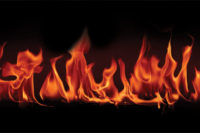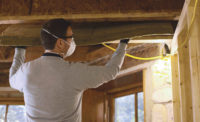Throughout the history of deadly catastrophic building fires, combustible wall and ceiling finishes have often played a significant role in the unfortunate number of fire deaths. In many of these fires, the wall and ceiling finishes contributed to a very fast moving fire. In fact, these fires moved so quickly that conditions in the building became deadly in a matter of minutes. As a result, the fire protection engineering community has worked tirelessly to develop better testing methodologies, and stricter fire and building code requirements for wall and ceiling finishes.
When designing buildings to make them safer from fire, it is the fire protection engineer’s goal to ensure that during a fire, it takes less time for the building occupants to evacuate to a safe place before conditions in the building become untenable. Fire protection engineers do this by analyzing how buildings are used, how fires start, how fires grow, and how fire and smoke affect people, buildings and property. Additionally, they use the latest technologies to design systems that control fires, alert people to danger and provide means for escape. This includes ensuring that the proper interior finishes are installed for the appropriate occupancy and location in a building.
FIRE DEVELOPMENT
There are several reasons why combustible finishes play a critical role in fire development. First, combustible finishes provide additional fuel loading in the building. At the same time, these finishes provide a pathway for fire to spread throughout a building. Additionally, during a fire, finishes can produce smoke and deadly fire gases that can obstruct visibility during evacuation or have physiological effects that can result in disorientation or death.
EARLY HISTORY
During the 1940s, there were several deadly fires where combustible finishes contributed to a high death toll. The most deadly was at Boston’s Cocoanut Grove Nightclub in 1942 that left 492 dead. In this fire, the cloth-covered walls and ceilings provided a means for the fire to move quickly throughout the building. Combustible finishes also played a significant role in three other deadly fires in 1946: LaSalle Hotel, Chicago, (61 fatalities), Canfield Hotel, Dubuque, Iowa (19 fatalities), and the Winecoff Hotel, Atlanta (119 fatalities). These fires focused the fire protection community’s attention on the need to install safer wall and ceiling finishes in buildings.
STEINER TUNNEL TEST
Although developed in the early 1900s, the Steiner Tunnel Test (ASTM E-84/NFPA 255) is still the most widely used fire testing apparatus for determining surface flammability for wall and ceiling finishes. In this test, a 25-foot long test specimen is placed in the horizontal position in a test chamber. At the start of the test, gas burners ignite the underside of the test specimen. The flame spread across the sample is documented. At the conclusion of the test, the material is assigned a flame spread index that accesses the speed that fire spreads across the material. Finishes that are assigned a higher FSI are expected to exhibit a faster surface flame spread than ones with a lower rating.
Additionally, the reduction of light inside the test apparatus from smoke is documented. This test data is used to establish a smoke developed index. The purpose of the SDI is to access the visual obscuration that results from smoke when the sample is burning. A low rating would indicate greater visibility when compared to a sample with a higher SDI.
FIRE AND BUILDING CODES
The fire and building codes assign a classification for a finish based on the FSI and SDI established during the Steiner Tunnel Test. Each tested material is assigned one of the following classifications:
- Class A – FSI, 0-25 and SDI, 0-450
- Class B – FSI, 26-75 and SDI, 0-450
- Class C – FSI, 76-200 and SDI, 0-450
- No Classification – FSI >200 or SDI >450
The basic assumption behind these classifications is that a Class A finish will provide a less severe fire hazard than a Class B finish; and a Class B finish is less severe than Class C finish. The building and fire codes allow different classifications of finishes to be installed in a building based on the occupancy classification of the building and the location of the finish in the building.
In addition, the codes recognize the role automatic fire sprinkler systems have in controlling fires. As such, a reduction in the classification is usually permitted if the entire building is protected by a fire sprinkler system. For example in an area where only Class A is permitted, Class A or B would be permitted if a fire sprinkler system is installed.
ROOM CORNER TEST
Because the Steiner Test only tests a material in the horizontal position, the results observed during the test may not always replicate the conditions that are found in an actual building fire. An alternate test to the Steiner Test is the Room Corner Test (NFPA Standard 286—Standard Methods of Fire Tests for Evaluating Contribution of Wall and Ceiling Interior Finish to Room Fire Growth).
In the Room Corner Test, the finish material is applied to three walls and the ceiling in a 768-cubic-foot test room. A gas burner that is placed on the floor at one of the room corners is ignited for 15 minutes. At the conclusion of the test, the tested finish passes or fails. Failure is established if one of the following occurs:- Flame spreads to the ceiling during the first five minutes of the test
- Flashover occurs
- The peak heat release rate exceeds 800 kw
- Smoke released does not exceed 1,000 square meters
If a material passes the Room Corner Test, the materials are permitted to be used where interior wall and ceiling finish is required to be Class A.
TODAY
Despite all the advancements over the last 100 years, we still see fires where combustible finishes are a contributing factor to the high number of deaths today. In 2003, indoor pyrotechnics used during a band’s performance ignited polyurethane foam that lined parts of a nightclub’s walls and ceilings at the Station Nightclub in West Warwick, R.I., resulted in 100 deaths. And on January 27, 2013, a nightclub fire in Santa Maria, Brazil, left more than 230 dead. Similar circumstances such as pyrotechnics mixed with flammable wall finish were responsible for the high number of deaths.
These fires still remind us of the consequences that can occur if the proper finishes are not installed and the importance on why the design, construction and enforcement communities should focus on installing safer finishes in buildings.






Report Abusive Comment